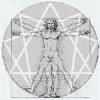“The fourth state of consciousness is called the objective state of consciousness In this state a man can see things as they are. Flashes of this state of consciousness also occur in man. In the religions of all nations there are indications of the possibility of a state of consciousness of this kind which is called ‘enlightenment’ and various other names but which cannot be described in words. But the only right way to OBJECTIVE CONSCIOUSNESS is through the development of self-consciousness. If an ordinary man is artificially brought into a state of OBJECTIVE CONSCIOUSNESS and afterwards brought back to his usual state he will remember nothing and he will think that for a time he had lost consciousness. But in the state of self-consciousness a man can have Hashes of OBJECTIVE CONSCIOUSNESS and remember them. Fragments: Eight
“The two higher states of consciousness — ‘self-consciousness’ and ‘OBJECTIVE CONSCIOUSNESS’ — are connected with the functioning of the higher centers in man. Fragments: Eight
“One of the most central of the ideas of objective knowledge,” said G., “is the idea of the unity of everything, of unity in diversity. From ancient times people who have understood the content and the meaning of this idea, and have seen in it the basis of objective knowledge, have endeavored to find a way of transmitting this idea in a form comprehensible to others. The successive transmission of the ideas of objective knowledge has always been a part of the task of those possessing this knowledge. In such cases the idea of the unity of everything, as the fundamental and central idea of this knowledge, had to be transmitted first and transmitted with adequate completeness and exactitude. And to do this the idea had to be put into such forms as would insure its proper perception by others and avoid in its transmission the possibility of distortion and corruption. For this purpose the people to whom the idea was being transmitted were required to undergo a proper preparation, and the idea itself was put either into a logical form, as for instance in philosophical systems which endeavored to give a definition of the ‘fundamental principle’ or from which everything else was derived, or into religious teachings which endeavored to create an element of faith and to evoke a wave of emotion carrying people up to the level of ‘OBJECTIVE CONSCIOUSNESS.’ The attempts of both the one and the other, sometimes more sometimes less successful, run through the whole history of mankind from the most ancient times up to our own time and they have taken the form of religious and philosophical creeds which have remained like monuments on the paths of these attempts to unite the thought of mankind and esoteric thought. Fragments: Fourteen
“But objective knowledge, the idea of unity included, belongs to OBJECTIVE CONSCIOUSNESS. The forms which express this knowledge when perceived by subjective consciousness are inevitably distorted and, instead of truth, they create more and more delusions. With OBJECTIVE CONSCIOUSNESS it is possible to see and feel the unity of everything. But for subjective consciousness the world is split up into millions of separate and unconnected phenomena. Attempts to connect these phenomena into some sort of system in a scientific or a philosophical way lead to nothing because man cannot reconstruct the idea of the whole starting from separate facts and they cannot divine the principles of the division of the whole without knowing the laws upon which this division is based. Fragments: Fourteen
“The development of the human machine and the enrichment of being begins with a new and unaccustomed functioning of this machine. We know that a man has five centers: the thinking, the emotional, the moving, the instinctive, and the sex. The predominant development of any one center at the expense of the others produces an extremely one-sided type of man, incapable of further development. But if a man brings the work of the five centers within him into harmonious accord, he then ‘locks the pentagram within him’ and becomes a finished type of the physically perfect man. The full and proper functioning of five centers brings them into union with the higher centers which introduce the missing principle and put man into direct and permanent connection with OBJECTIVE CONSCIOUSNESS and objective knowledge. Fragments: Fourteen
“So you see that art is not merely a language but something much bigger. And if you connect what I have just said with what I said earlier about the different levels of man’s being, you will understand what is said about art. Mechanical humanity consists of men number one, number two, and number three and they, of course, can have subjective art only. Objective art requires at least flashes of OBJECTIVE CONSCIOUSNESS; in order to understand these flashes properly and to make proper use of them a great inner unity is necessary and a great control of oneself.” Fragments: Fourteen

